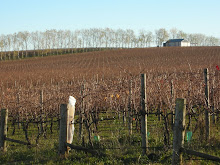Italian wine and grape varieties: the indigenous Nero d'Avola

Our sommeliers course is coming along like a house on fire after only two lessons, but then given the second level is all about Italian wine and Italian wine making regions, the material is so rich it’s hard to get beyond just touching on each region.
The first lesson this week was a review of how to taste wine – the descriptions you can give, serious measurements of wine quality etc. The Italian Sommeliers Association has a list of parameters and measurements that include intensity, complexity, harmony, after-taste persistency etc etc. But more on that later.
This week we tasted a Nero d’Avola, and after my father asked me about this wine and its variety, I thought I’d give it some greater analysis myself. Nero d’Avola is a native Italian wine, and an indigenous grape variety of Sicily. It is a red wine and it happens to be one of my favourites (though nothing for me from the shores of Italy will ever beat nebbiolo).
We tasted Deliella’s version, which finished with 88 points for the nero d’avola. It’s a wine that costs about 40 euros at a wine shop and so on my buying a second sample this week (purely to consolidate our lessons, you understand) I unfortunately had to acquire a less expensive wine.
My second nero d’avola shares many of the characteristics of the first, with a little less complexity. I’m drinking it too young, but then it’s difficult to find an enoteca (Italian wine shop) that will have any vintage beyond recent ones.
Deliella’s wine was filled with a bouquet of spice mix – everything from cocoa to tobacco and some under brush in between. Our lecturer that evening said that nero d’avola has a perfume all of its own and is very distinctive when you learn to recognise it – the perfume she was referring to was a brackish, sea-salt air smell. To push your imaginations a little, she’s right. Even my cheaper variety had this aspect, so we’re at least a step towards recognising the variety in a blind tasting. I think it also has a green wood smell – like raw pine.
I have seen this Italian wine in Australia, which so far has gone under-appreciated in Italy itself. I think it could have an export future as it's closer to an Australian palate than some northern Italian wines I've tasted. For being snubbed a little in Italy, I’m not sure if it’s a perception that there is a lack of wine growing tradition in Sicily, or if it just suffers from being a southern wine, but this Italian variety is definitely worth looking out for. Just don’t drink it too young.
Labels: nero d'avola, sicily, sommelier, wine tasting


0 Comments:
Post a Comment
Subscribe to Post Comments [Atom]
<< Home